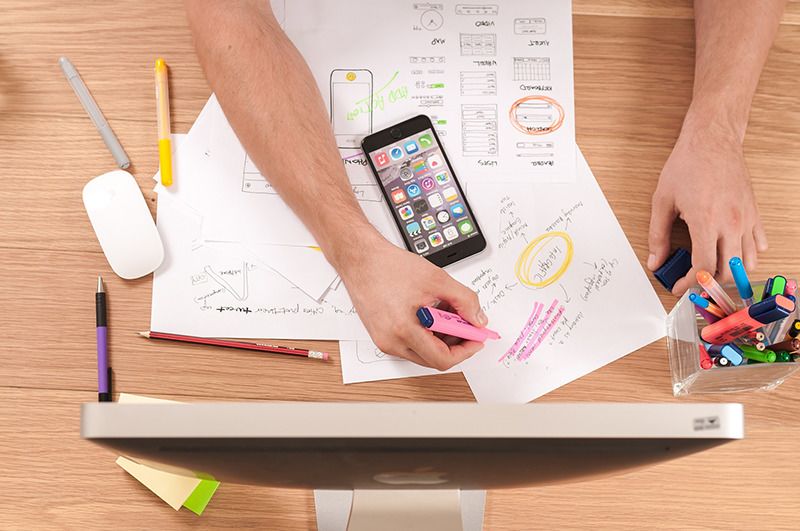If you listen to the news, you must have heard there’s a global hiring crisis. However, the headlines don’t tell the full story. For every person who’s striking out on their own rather than returning to their old job, there’s a business owner who has learned about the benefits of using freelancers rather than maintaining a full-time, in-house staff.
Whichever side of this issue you’re on, it’s apparent that non-traditional workforces are becoming the norm. We’ll look at some of the benefits of hiring freelance teams and offer some practical tips on how you can make the most of your relationships with your freelance designers.

Why Use Freelancers?
This widespread transition toward remote collaboration and outsourcing has been coming on for some time. The pandemic and resulting economic flux just accelerated the process.
You don’t have to be a large enterprise to benefit from working with a team of freelancers. Solo professionals and other freelancers also need outside help when aspects of a project require skills that they don’t have.
For example, a web developer may be great at back-end programming but know nothing about front-end design principles, or vice versa. Similarly, you may be an expert in your niche but not know a thing when it comes to web design or programming. One of the easiest ways for freelancers to learn new skills quickly is to invest in online courses. The average digital course in general only takes about fifteen weeks to complete, which is very doable for most people and will provide hands-on experience as well.
Even if you’re using a great web-building platform, you may still need professional designers to optimize your site and make it user-friendly. Working with freelancers provides you with access to a wider pool of talent and experience that isn’t limited by time zone or geography. It’s also a great solution to temporary or limited staffing needs.
Although working with a disparate group of personalities can lead to unpredictable outcomes, it also supports greater flexibility and widens the range of professional possibilities available to you.
Before building an expert freelance team, you need to know whether you’ll benefit from working with freelancers rather than going at it alone or hiring full-time staff. You should evaluate your current business and future plans, and then ask yourself the following questions:
- Is the cost of hiring freelancers more beneficial for my bottom line than the expense of having a full staff?
- Does my workload justify full-time, dedicated staff?
- What are my plans for future growth and expansion?
- Is my company lacking a vision, diversity, or reach that could benefit from a new perspective?
- Is my business model one that would benefit from remote collaboration, such as a global enterprise or an eCommerce platform?
Once you have a better idea of your needs, you need to find the right people to help you meet them.
Choosing and Managing Freelance Teams
Whether you’re a developer who routinely works with freelancers or you need to build a team for a special project, choosing and managing freelancers is not the same as hiring in-house staff.
Freelancers are not employees of your company, so there are different legal requirements in terms of taxes and compensation. For this reason, the status and compensation of freelancers must be clearly outlined from the beginning.
This more independent style of freelance work also changes the way you approach, manage, and interact with freelancers. Expectations on both sides will differ, as will incentives and motivations. In order to succeed, all stakeholders should be on the same page and clear in their goals and expectations from the start.

Here are five tips that will help assure a smooth, mutually beneficial association with your freelancers.
1. Establish Reasonable Guidelines and Expectations
Freelancers are not dedicated employees. They may work odd hours or be juggling other clients and projects besides yours. Before you commit to hiring a freelancer, make sure that you outline duties, deadlines, and expectations upfront.
Clearly delineate what you expect from them and what they can expect from you, and make sure that you’re in agreement. Put everything in writing, including compensation, credit, attributions, and timelines. Make sure to outline consequences and remedies if either party fails to live up to their end of the bargain.
Clear, consistent communication is essential. Not only should the initial agreement and all expectations be put into writing, but all follow-up communications should be clear, timely, and to the point. Miscommunications or misunderstandings should be addressed and cleared up immediately.
2. Compensate Fairly
Remember that freelance work doesn’t equate to cheap labor. Keep in mind that the minimum acceptable rate for freelancers is about $45 per hour in the United States, which is probably less than you will be paying a salaried employee. But more specialized designers will likely charge double that or more. Even if you’re mainly choosing this route because it’s more cost-effective for your business, you’re still paying for professionals who have the skills and expertise you lack.
You get what you pay for, so compensate accordingly. Most freelance platforms will show your history of payment and ratings from freelancers who have worked with you, and experienced freelancers will be on the lookout for scams on these platforms. So, it’s also in your best interest to prove that you value your workers with pay commensurate with their experience.

3. Build Trust and Rapport
When you’re collaborating with multiple freelancers who are used to a certain level of autonomy, it’s important to establish trust. Sure, it’s equally important to outline expectations and set deadlines. But, you need the peace of mind that comes with having faith in your team and their abilities, and they also need to know that you will deliver as promised.
4. Be Present and Supportive
Sometimes, it’s tough to be a freelancer, and we’re often remotely working on our own. Be present and supportive by providing regular feedback and encouragement for your workers.
Keep the lines of communication open, and make sure that you’re available if problems crop up or there’s an issue that needs addressing. You might want to create a schedule for formal weekly meetings as well as informal check-ins, even if that just means a pep session before the workday begins.
5. Set Up a System for Tracking and Accountability
Your freelance team must be accountable for their actions, adherence to deadlines and standards, and the quality of their work. But as the project manager, the buck stops with you. It’s your job to deliver to your clients according to the terms of your agreement and their expectations.
As long as you’ve followed the above tips in this guideline, the project should proceed smoothly. Know the difference between hard deadlines, such as filing dates for building permits, and soft deadlines. Clearly state the consequences for failing to perform to standards or deliver on time. This will encourage accountability and hold everyone to a higher standard of work.
Conclusion
Since the start of the pandemic, remote work and virtual collaboration have been on the rise. Whether you’re working with a team of freelancers for a one-time project or you have an ongoing need for freelance writers and editors, learning to manage your team effectively will streamline the whole process and produce better outcomes.



